In winter, it is often wildfowl to which we turn our attention. Aythya ducks are common and widespread, and even the lowliest wetland patch watcher has a chance of finding one of the scarce or rare species, as cold weather movements reshuffle the ducks at various sites. But look carefully through those Tufted Duck: hidden among them could be the scarce Greater Scaup, or the Nearctic vagrant Lesser Scaup.
Identification is not always straightforward, however. This group of ducks has a variety of plumages and, to make matters worse, is notorious for producing hybrids, some of which can appear very similar to one of the parent species or even to another species altogether.
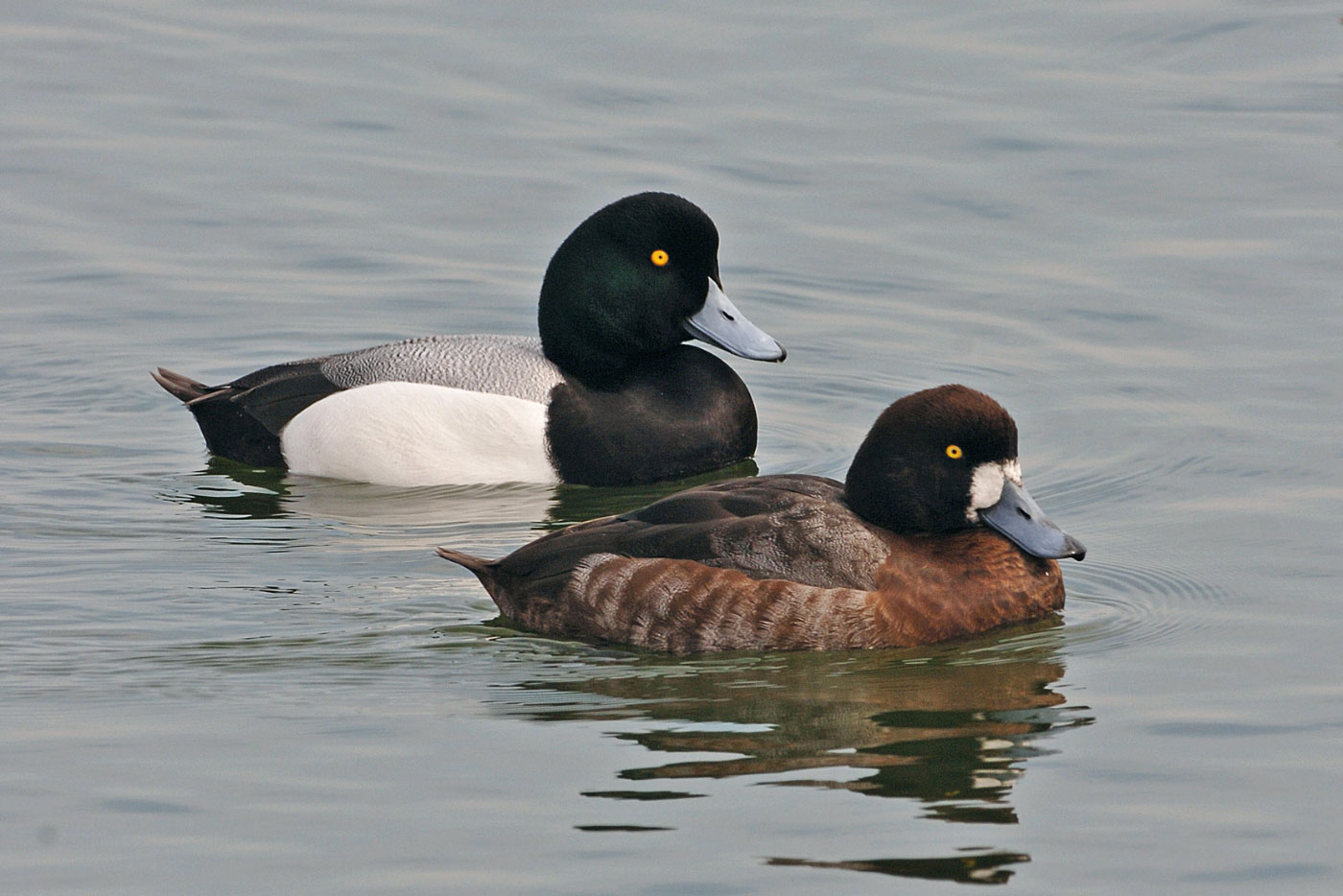
Adult drake (left) and adult female Greater Scaup (Seaforth, Lancashire, 23 March 2006). Both these birds show the large rounded, rather bulbous head and heavy body typical of Greater Scaup. The female shows some grey tones in the mantle which reduce the contrast with the flanks and make the head look dark, while the white around the base of the bill is very extensive and meets over the culmen (Steve Young / www.birdsonfilm.com).
Tufted Duck
This is by far the commonest Aythya and therefore the most familiar. Though a scarce breeding bird in Britain, it is much more regular in winter, when numbers are boosted
by continental migrants. At this time of year, any lake, reservoir or gravel pit should host this species, as well as its frequent companion, Common Pochard.
Tufted Duck generally shuns the coast, but is reliably found in any freshwater habitat with water deep enough. Numbers at some sites can be very large, making the task of sifting through them a long one.
Many will be the easy-to-identify black-backed and white-flanked adult males. At closer range, the characteristic shaggy crest will be easily seen.
Females and first-winters are a dark chocolate-brown colour and look much more anonymous. As in all three species, however, young males will steadily acquire male plumage characters during the winter.
On such birds, look for their small size and neat, compact proportions, a steep forehead, rather flattish crown and a vestigial nape tuft. Tbe solid dark brown upperparts contrast strongly with the flanks, and there is a small and diffuse white patch around the bill base, though this is often absent.
The bill is rather broad and an extensive dark bill tip extends back beyond the 'nail'. In flight or when flapping, the wing-bar is white, but becomes greyer and more diffuse across the outer primaries.
Greater Scaup
This species is a winter visitor and in most cases confined to coastal waters. It is a bird with a northerly distribution and is quite scarce around southern English coasts. Somewhat paradoxically, therefore, many of us see this species most frequently away from the coast, as a straggler to inland freshwater, where it will readily consort with its commoner Tufted Duck and Pochard cousins. Here the task is to pick it out among a possibly large flock of other Aythya species.
An adult male Greater Scaup is readily identified by its smooth pale grey mantle – with very fine vermiculations – contrasting with white flanks, black breast and black rear end. The head lacks a nape tuft.
Females and first-winters, however, are essentially brown. On such birds look for their larger size and body bulk and length, somewhat sloping rear end, a rather large, rounded, almost bulbous head, with a steep forehead and a large, very broad bill.
Incipient grey in the upperparts will make the head contrast darker and there is little contrast between mantle and flanks. There is a large and distinctly defined (though variable) white patch around the bill base, which usually meets over the culmen, and a pale area on the ear coverts (on females in late winter), while the dark at the bill tip is restricted to the nail or the area immediately adjacent. The spread wing pattern is similar to that of Tufted Duck.
Lesser Scaup
This is a true rarity, though now one which occurs annually. Long clouded by confusion with hybrids, the first was identified as recently as 1987, in Staffordshire, but since this breaking of the credibility barrier, Lesser Scaup has been shown to be a vagrant in small numbers every year, with more than 150 records.
It frequents freshwater habitats and can occur anywhere which attracts Aythya ducks, with the result that most counties in Britain have now hosted at least one.
In some ways this species is intermediate between Tufted Duck and Greater Scaup, being, put very crudely, the size of the former with the plumage of the latter. Adult males show a grey back like Greater Scaup, though it will be more clearly and more coarsely vermiculated dark grey, especially at the rear, and should appear slightly more restricted in extent.
On females and first-winters look out for their small size and compact proportions – even more than Tufted Duck – but with a strongly sloping forehead and peaked rear crown, although beware the similar effect which can be created by a Tufted Duck's tuft.
Like Greater Scaup, incipient grey in the upperparts makes the head contrast darker, and there is little contrast between mantle and flanks. There is a large and distinctly defined, though variable, white patch around the bill base and the dark at the bill tip is restricted to the nail only.
In flight or when flapping, the wing-bar is white on the secondaries but distinctly grey across the primaries. On most, the divide between these two feather tracts is sharp.
Hybrids
In most identification conundrums, the hybrid option is pretty unlikely – a last resort when all else fails. However, hybrid Aythyas are common, not only involving the three species considered here but also Ferruginous and Ring-necked Ducks (at least). Sadly, therefore, any putative Lesser Scaup runs a very high risk of being a hybrid.
A good proportion of hybrids come from wildfowl collections, where the mixture of species and their close proximity provides opportunities for miscegenation. Unsurprisingly, therefore, hybrids come in many different guises. Fortunately a number of recognisable hybrid types have been identified, though it is mostly males that will be picked out. Female hybrids are more likely to escape detection.
Of most relevance here are Greater Scaup × Tufted Duck hybrids (which can resemble Greater Scaup) and Common Pochard × Tufted Duck hybrids (which, perhaps surprisingly, look a lot like Lesser Scaup).
The golden rule with Aythyas is to examine every single feature critically. If your bird exhibits all the classic features of a particular species with no anomalies, then it is probably what you think it is. However, if anything is not quite right (maybe the dark on the nail is a bit too extensive, for example, or the degree of mantle vermiculation is not quite strong enough) then a hybrid is the most likely option.

Drake Tufted Duck (Sand Lake, Lancashire, 10 January 2009). This male Tufted Duck is straightforward to identify: it has solid black (not grey) upperparts and clean, sharply defined white flanks, while its purple-sheened head has a long and obvious dangling crest. Note that the dark on the bill tip is very extensive, extending well beyond the nail, unlike in the two scaup species. The bird also looks typically small and compactly proportioned. Birds this close with this classic set of features should present no identification problems at all (Steve Young / www.birdsonfilm.com).
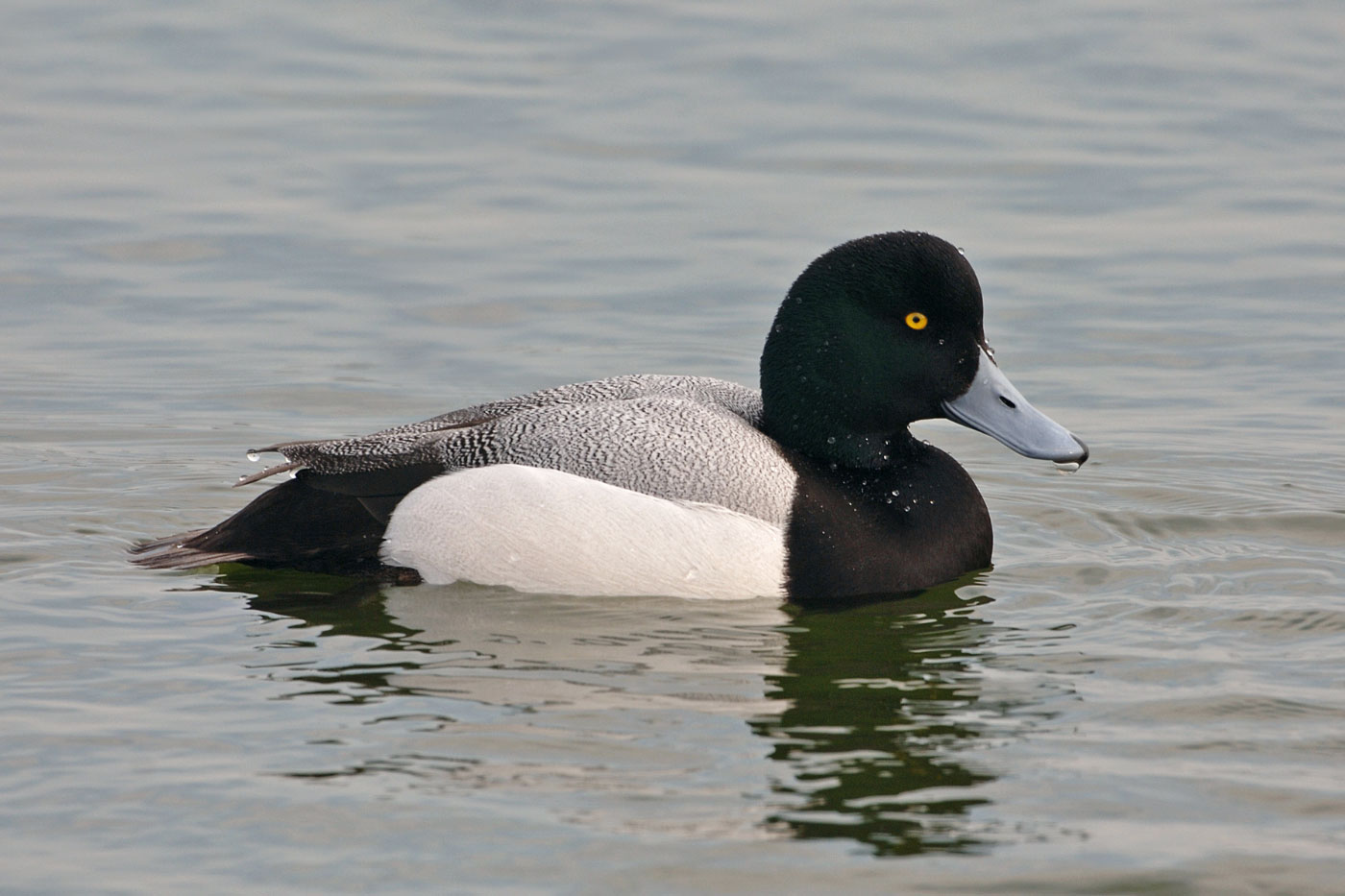
Drake Greater Scaup (Seaforth, Lancashire, 23 March 2006). This is a classic portrait of a drake Greater Scaup. In comparison with the Tufted Duck above the head looks large and rounded with a steep forehead and no crest. The body also looks large and the whole bird seems to sit higher out of the water. The bill also looks large and broad. As for plumage, the head is nicely glossed green, the mantle is a soft pale grey with only very faint vermiculations and the dark at the bill tip is confined to the nail and therefore barely visible in a side-on view (Steve Young / www.birdsonfilm.com).

Drake Lesser Scaup (Cosmeston Lakes, Glamorgan, 30 March 2012). This drake Lesser Scaup shows the classic combination of small, compact, short-bodied, rather Tufted Duck-like proportions and rather Greater Scaup-like plumage. However, although superficially resembling Tufted Duck in shape, the head is less rounded with a steeper forehead and a rear crown 'bump', though no tuft. The basic plumage pattern is that of Greater Scaup with green-glossed head and grey mantle, but the latter appears darker due to the coarser vermiculations and the flanks also have subtle grey wavy lines. Like Greater Scaup, the dark at the bill tip is restricted to the nail and almost invisible here (Chris Hawes).
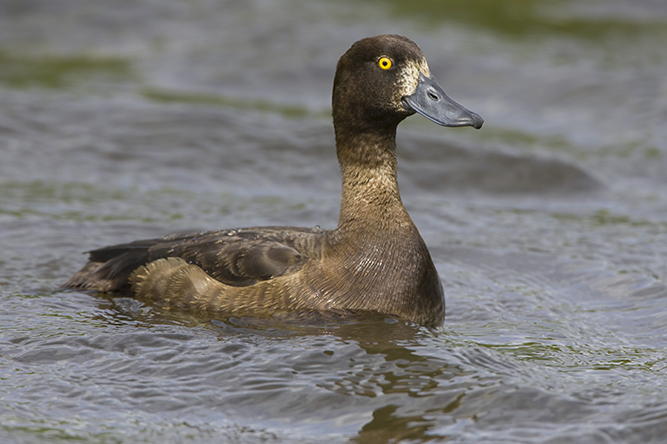
Female Tufted Duck (Terschelling, The Netherlands, 27 June 2007). With its neat proportions, small rounded head and small body, this looks immediately like a Tufted Duck even though there is no hint in this posture of a tuft at the rear crown. A glance at the plumage confirms the identification: the mantle is brown with no incipient grey and is also quite dark, contrasting with the flanks, and the pale surround to the bill is both off-white and quite poorly defined. Finally, the dark bill tip is diffuse and extensive (Arie Ouwerkerk / www.agami.nl).
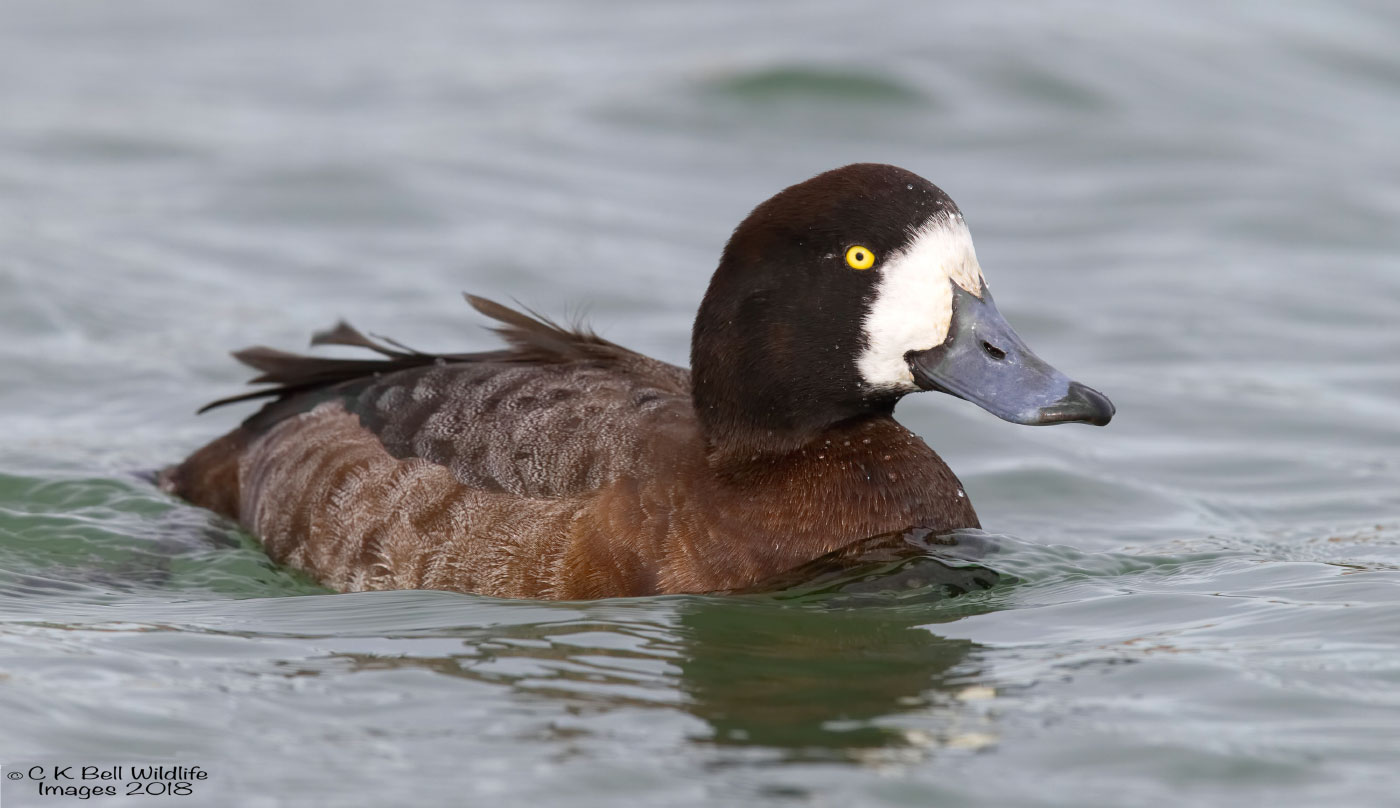
Female Greater Scaup (West Kirby Marine Lake, Cheshire, 9 March 2018). With its pure white, sharply defined and extensive facial patch, this bird already looks like a good Greater Scaup candidate, an impression confirmed by its mantle which, containing both brown and grey feathers, is quite pale and offers little contrast with the flanks, though it does enhance the darkness of the head. In terms of structure, the head is large and rounded with a steep forehead and the body also looks large, riding high out of the water (Craig Bell).
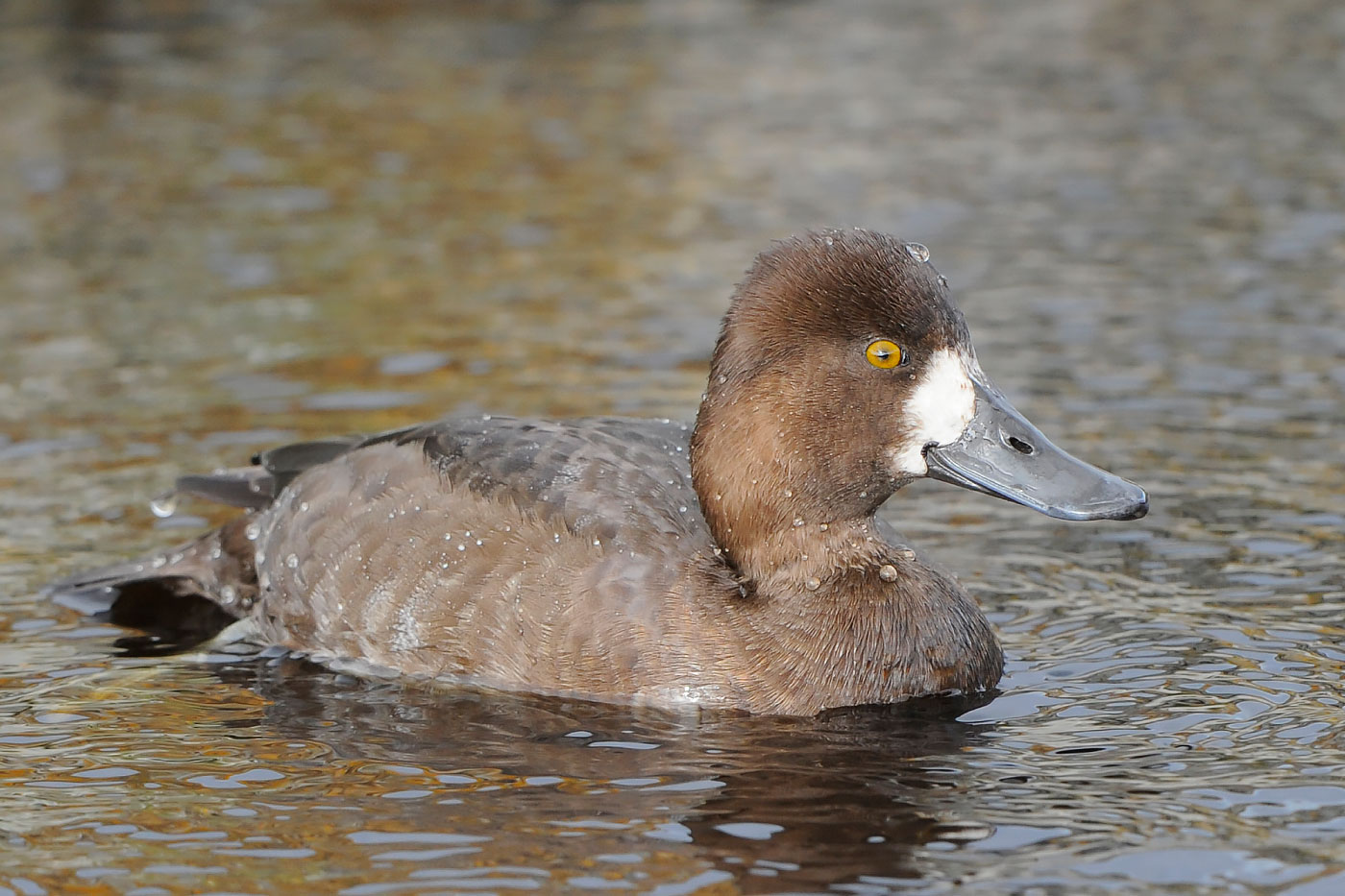
Female Lesser Scaup (Fair Isle, Shetland, 7 October 2011). This bird superficially resembles a Tufted Duck in its small, neat proportions. However, the mantle is quite pale and offers limited contrast with the flanks. Furthermore, the facial patch is very white, extensive and sharply defined and meets well above the culmen and the dark at the bill tip seems to be restricted to the nail. Adding further weight to the case for Lesser Scaup is the steep forehead and rather high rear crown. A good flap and a view of the wing pattern would clinch this bird (Rebecca Nason / www.rebeccanason.com).
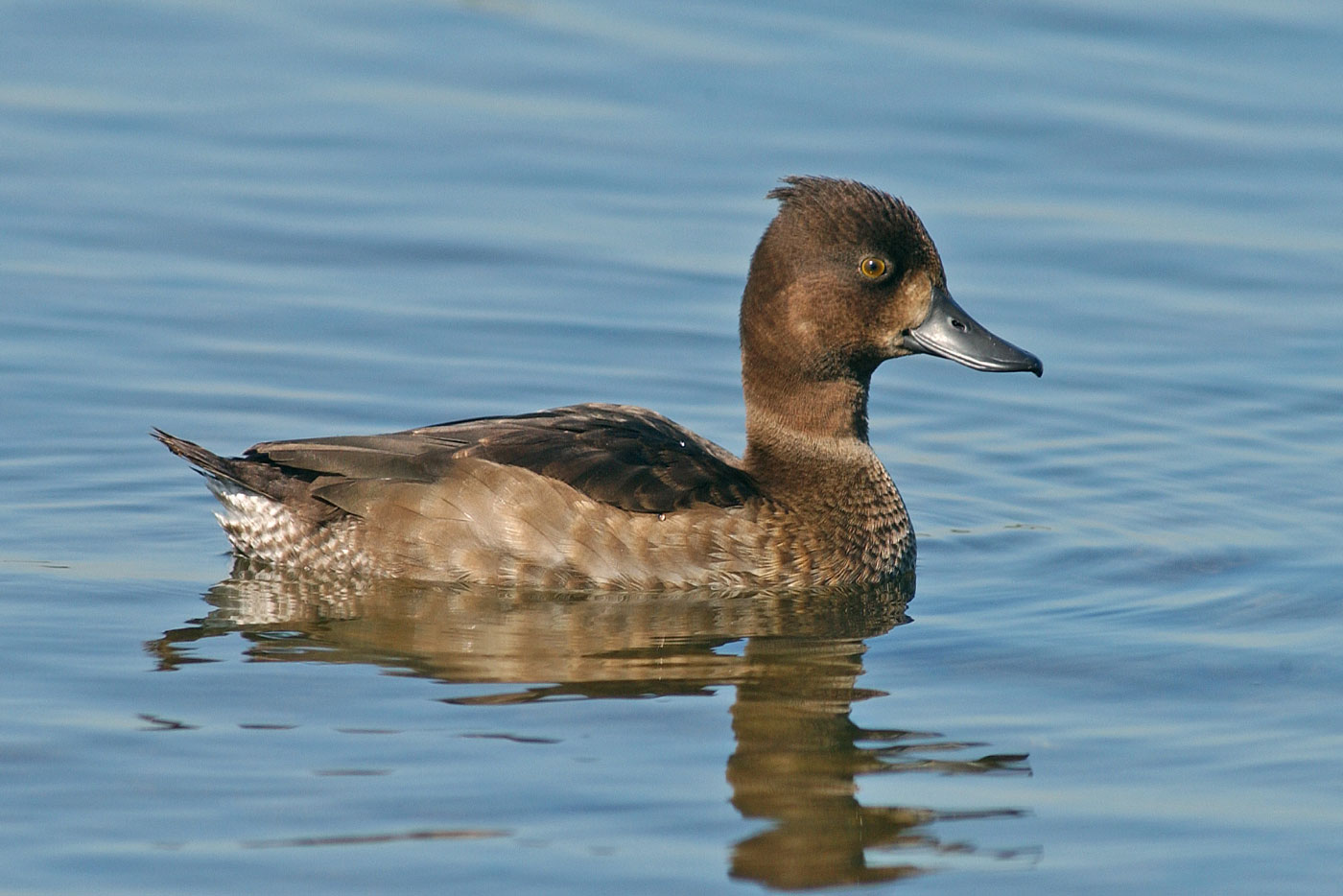
Juvenile Tufted Duck (Seaforth, Lancashire, 9 September 2004). This young Tufted Duck looks typically small, squat and short bodied, and the rather flattish crown with a pronounced tuft is shown by no other Aythya. To confirm the identification we should look at the plumage and bare parts too. Here lie ample clues to the bird's identity. The mantle is very dark brown and contrasts sharply with the flanks, the facial patch is almost non-existent and the bill has an extensive but diffuse dark tip. In all respects this is a normal juvenile Tufted Duck (Steve Young / www.birdsonfilm.com).
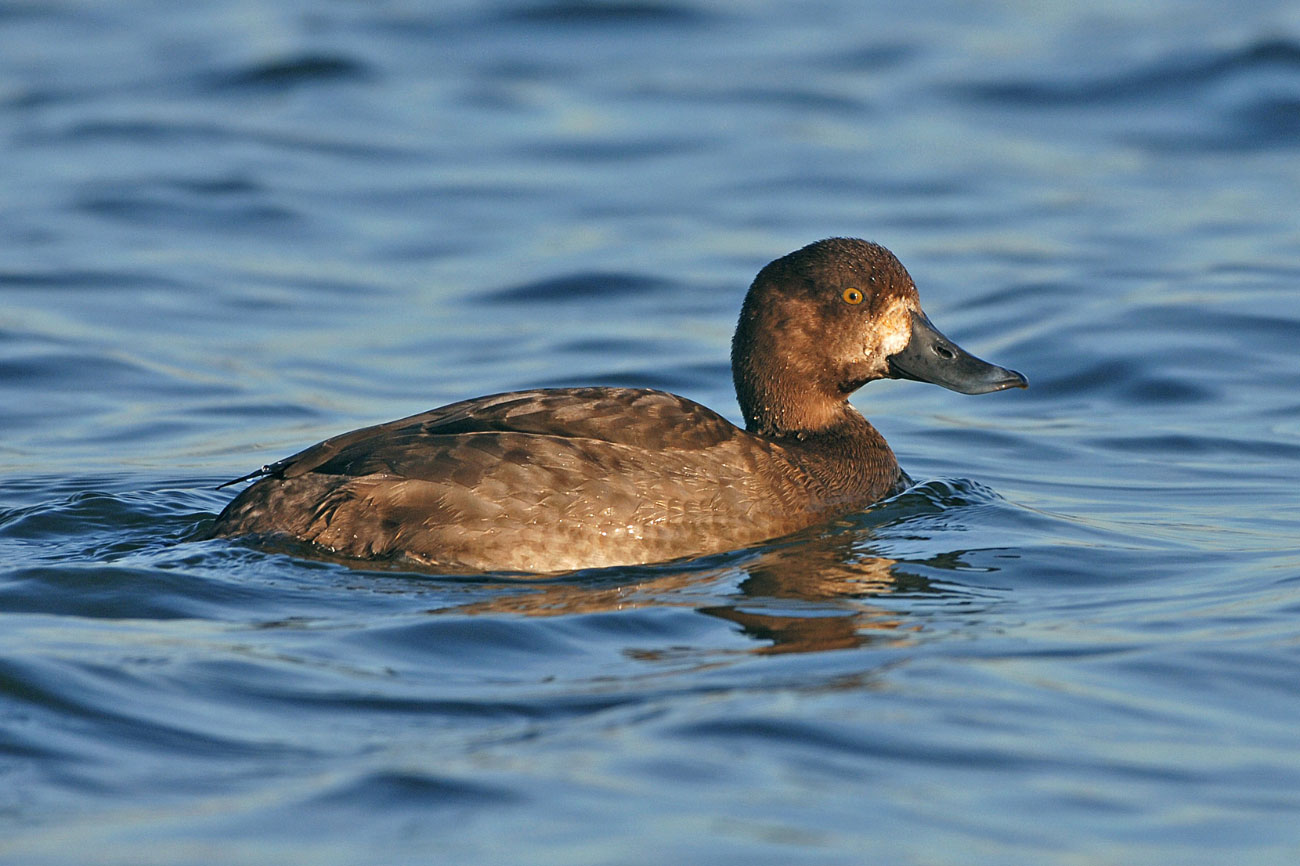
First-winter Greater Scaup (Seaforth, Lancashire, 19 November 2005). With its large bulky body, long sloping rear end, large, very rounded, bulbous head and large bill, this looks immediately like a Greater Scaup. To confirm our quick identification, there is minimal mantle/flank contrast and the whole body looks quite uniform in both hue and tone. The facial patch is still developing, but it is already large and reasonably well-defined and extends over the culmen. The bill pattern, though difficult to establish on this side-on photo, appears to show a dark nail only (Steve Young / www.birdsonfilm.com).
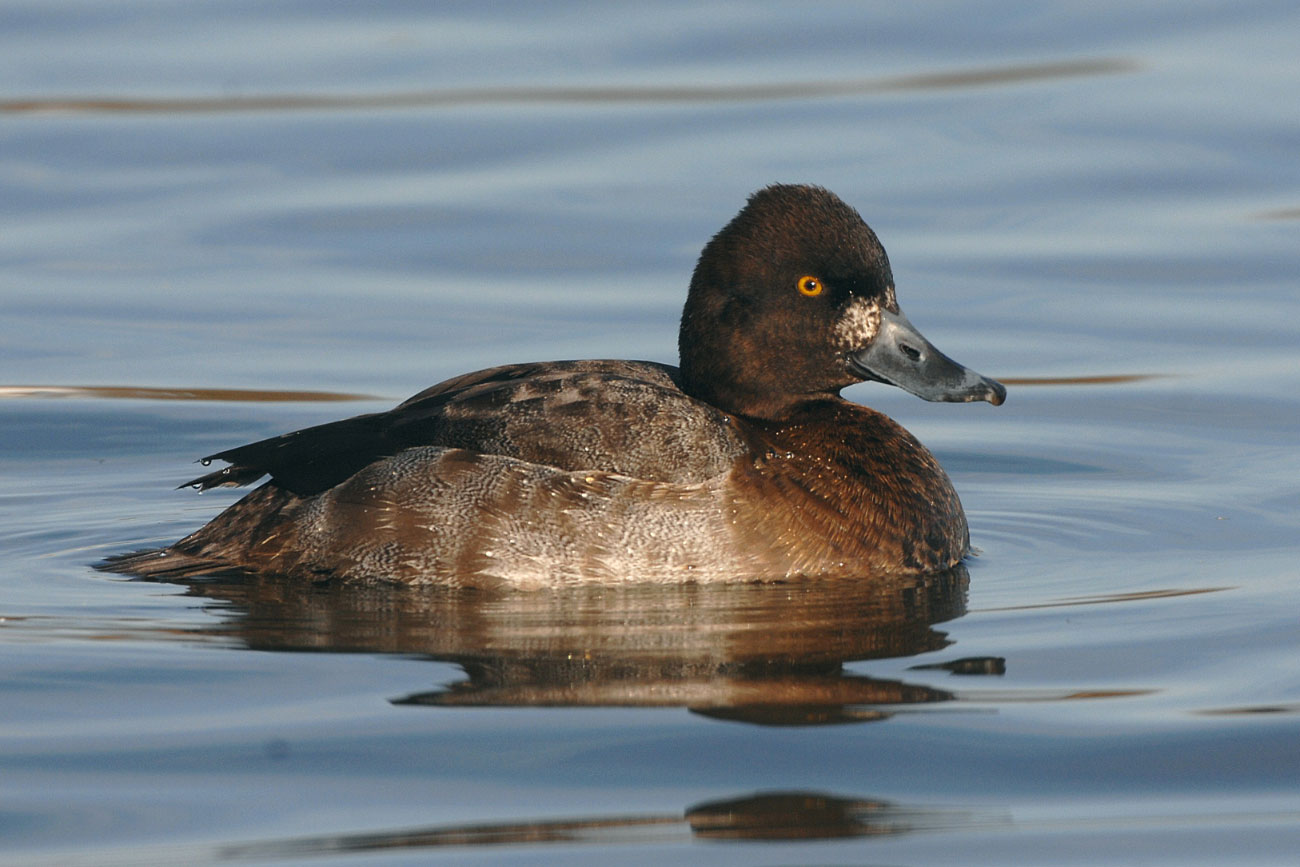
First-winter female Lesser Scaup (Caerlaverock WWT, Dumfries and Galloway, 18 February 2007). Again, this young Lesser Scaup shows features suggestive of both Tufted Duck and Greater Scaup. Its small body and neat proportions suggest the former while its grey mantle clearly indicates the latter. On closer examination, however, it contains all the necessary features of a Lesser Scaup: a steep forehead and 'bumpy' rear crown, much grey in the mantle reducing the contrast with the flanks and heightening the contrast with the dark head, green gloss coming through on the head, a developing white facial patch and a dark nail (Steve Young / www.birdsonfilm.com).
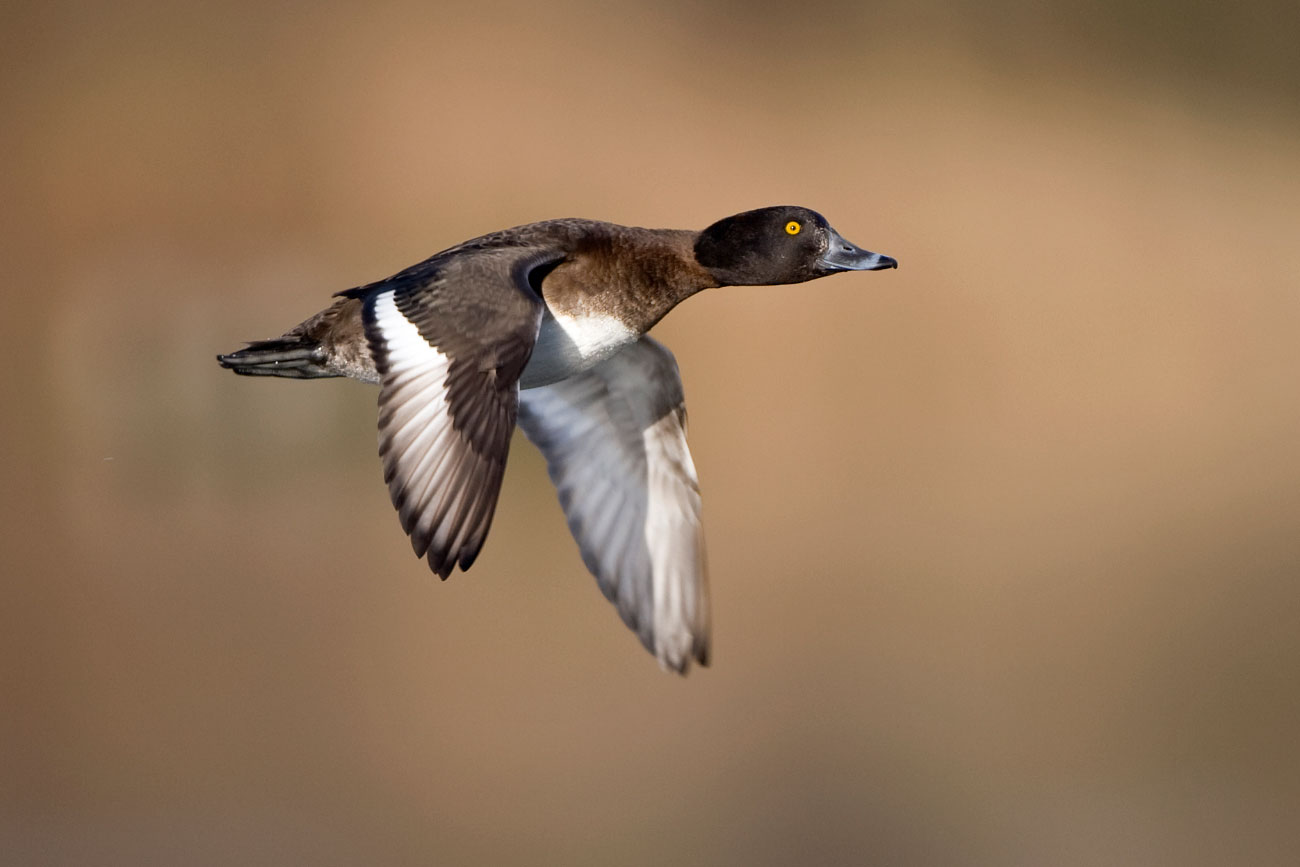
Tufted Duck (female, Whitlingham CP, Norfolk, 10 January 2009). The most eye-catching feature of any flying Aythya is the broad white wing-bar. That on this bird is typical of both Tufted Duck and Greater Scaup: white on the secondaries but progressively greyer or browner across the primaries. The head and bill confirm that this is a Tufted Duck, however – it lacks a white facial patch and the dark on the bill tip is extensive (Robin Chittenden / www.robinchittenden.com).

Female Greater Scaup (Seaforth, Lancashire, 8 February 2005). The wing-bar on this flying Greater Scaup resembles that of Tufted Duck, but the white facial patch is strong and prominent, seemingly encircling the bill base, and the dark at the bill tip can be seen to be restricted to the nail. The bird also looks large bodied and round headed, also typical of Greater Scaup (Steve Young / www.birdsonfilm.com).

Female Lesser Scaup (St Mary's, Scilly, 15 November 2015). This flying Lesser Scaup shows the a developing large white facial patch typical of this species, but the key feature in flight is the wing-bar – white across the secondaries with a sharp, abrupt transition to grey across the primaries, unlike the more gradual transition in the wing-bars of the other two species (Kris Webb).
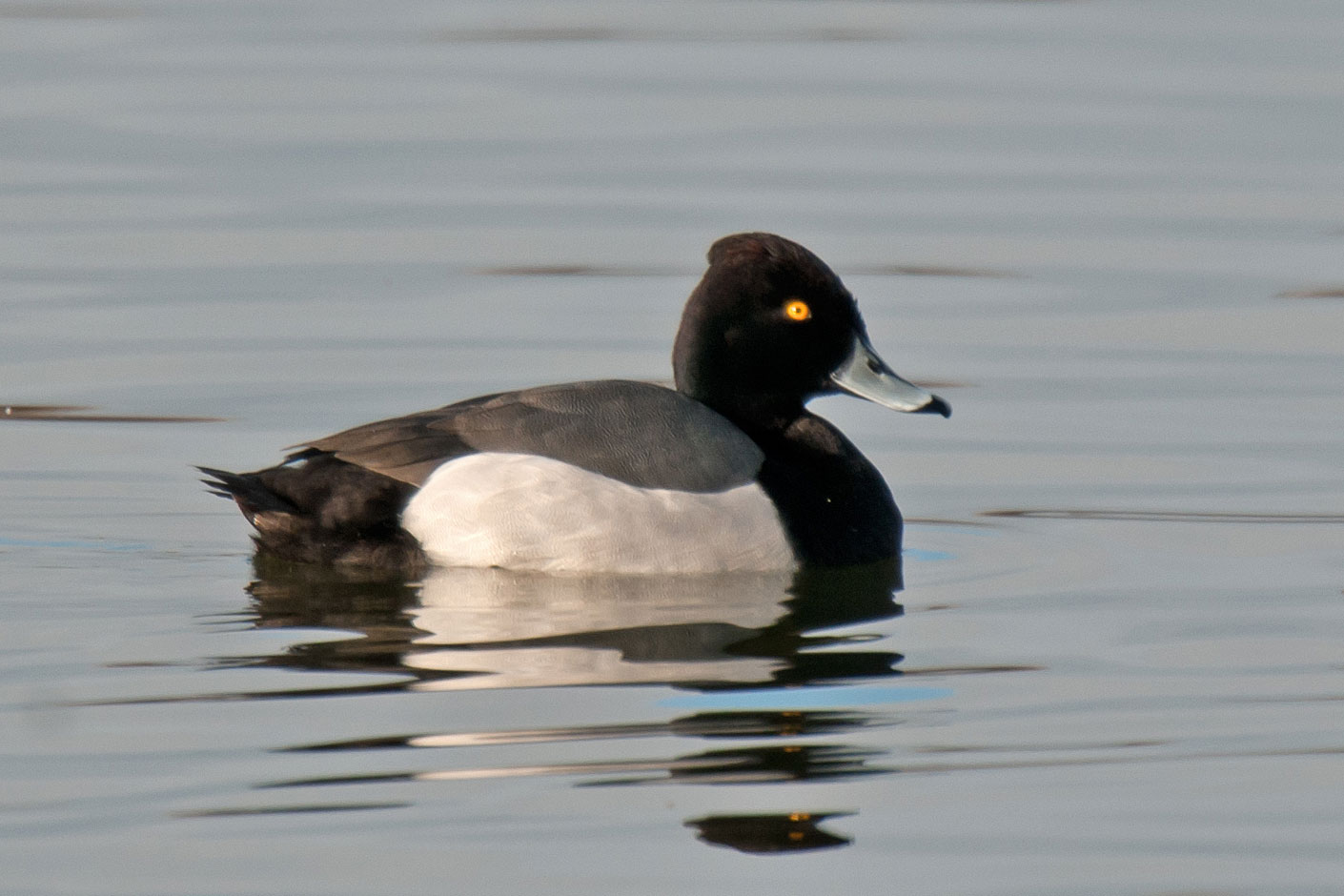
Drake Aythya hybrid (male, Seaforth, Cheshire, 28 January 2009). This bird shows a small, rather Lesser Scaup-like head combined with a rather Tufted Duck-like rear crown tuft and a large bulky Greater Scaup-like body. The mantle is grey but appears very smooth, lacking even the soft vermiculations of Greater Scaup, while the bill shows extensive dark at the bill tip. This combination of features is not shown by any Aythya species and the bird must therefore be a hybrid (Steve Young / www.birdsonfilm.com).
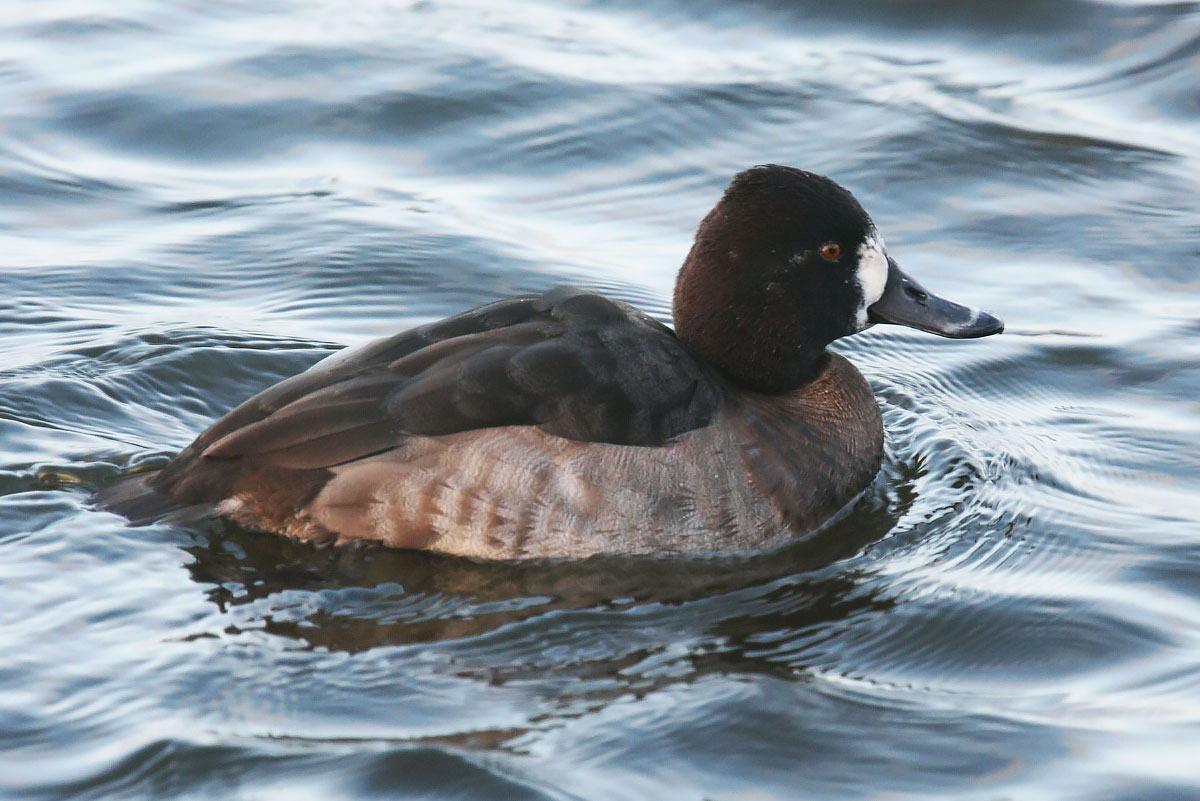
Female Aythya hybrid (Welney, Norfolk, 2 January 2008). This bird has quite a large body, a rounded head and a strong white facial patch, all suggestive of Greater Scaup. However, the head also shows a slight rear crown 'bump', there is a strong contrast between the mantle and the flanks and the bill has extensive dark at the tip. Again, this bird shows characters of no known species and must also be a hybrid; identifying the parentage of such birds is not always straightforward. Photo: Alan Tate.
- This article was originally published in the January 2013 issue of Birdwatch magazine.





